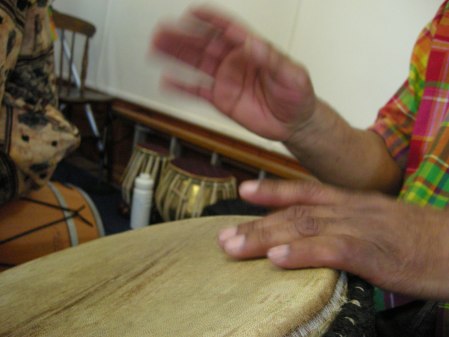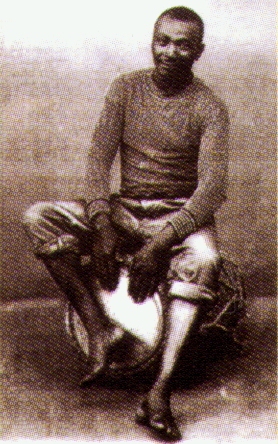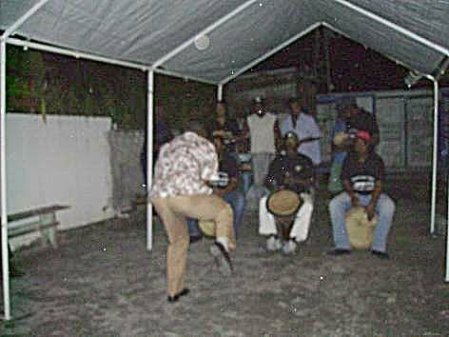
Speaking about gwo ka is speaking about the soul of Guadeloupe, its personality, its originality. It is both a musical expression, which was born in the suffering of slavery, which was prohibited, repressed, “marooned”, but which also resisted to accompany its people in its destiny, like its language, creole. Gwo ka is also a “reason of being, walking, talking, dancing” and also convey a sense of spirituality.
Gwoka is a music born in Guadeloupe during the dark period of slavery. Created from African rythem, it has geniously developed seven fondamental rythms.
– Toumblak
– Graj
– Mendé
– Woulé
– Granjanbèl or Pajambèl
– Kaladja
– Léwòz

The instruments
Gwo ka is played ideally with at least 3 “Ka”: 2 “boula” and 1 “makè” both having more or less the same size. A “Ka” can be described as being made of:
– 1 baril called “bouko” in créole language
– 1 goat skin (po a kabrit) male for the “boula” et female for the “makè”.
– 2 “sèk” to maintain the ropes
– 2 “klé” to squeeze all
– the rope called zoban.
The calabash, called “chacha”(emptied, dried then filled with grains) often accompany the “Ka”, more than the “tibwa”.
Rythms and dances of gwoka
Gwoka takes its origin essentially from African dances (Congo dance, snake dance) and evolved giving predominance to soloist or couple dances, as was the “Kalenda”.
Gwoka is the union of music dance and spirit, a trilogy of sounds: two low-pitch and one high-pitch:
– The two boula as the base of the seven musical environment of gwoka
– The “Makè”, unique is placed at the centre to follow, feel, discuss, whisper and mark any of the dancer’s gesture, matching the rhythm and energy of the dancers, becoming their shadow, and establishing a real dialogue between the sound and the gestures.

The rhythms of Gwoka were further elaborated over the years. It is made of 7 basic rhythms, which correspond to 7 ways of singing and dancing, such as:
– The Tumblak: (most famous), which is the dance of love, fertility and joy, and suggestive postures. It become “Tumblak chiré” when the rhythm is accelerated.
– The Graj: dance initially associated to work, evoking the different phases of the making of the manioc flour. It is similar to the Tumblack, but slower and more accentuated. It is used by woman dancers as a seductive dance. Unlike the Tumblack, the “repriz” is marked three times.
– The Mendé: this is the rhythm and dance associated to the carnival. It symbolize the collective evasion, incite to the walking pace of demonstration/defile.
– The Woulé: the only rhythm on 3 times. It is a kind of airy valse, also called “balloon” (Balon), and was in the past danced with a foulard. This is also associated to work.
– The “Granjanbel” or “Padjanbel: originally associated to the work in the plantation, it has become the dance for the warriors.
– The Kaladja: Slow rhythm; express pain, reflection, sorrow. It can also been danced as a “couple dance”.
– The Léwòz: the more complex and difficult rhythm to play. It is a dance for incantation, and originated the rebellion in of the XVIIIth century. There are two type of Léwoz, one of them is the “Léwòz indestwas”. .
Generally, in gwoka you could find two types of dance: dance for entertainment such as (such as Tumblak, Tumblak chiré, Léwoz, Mendé, Woulé, Granjanble, Kaladja) martial dances (Mayolé, Sové-vayan, Chatoux, Koévalin, Bènaden). Each is accompanied by gwoka ensemble and call-and-response singing.

There are other rythms in gwoka than the traditional seven basic and martial ones. They include: Sobo, the 6/8, the Takout, the Grap a Konngo, and the “Command” Lewoz (Léwòz au commandement ) where a leader would command the dancers as done for the quadrille.
The rhythm Léwòz should not be confused with the Swaré- Léwòz, where people join in a space (generally a circle) of expression mixing fascination, improvisation. The Swaré- Léwòz is formed of:
– a vocal space dedicated to the choral (chantè and repondè), story tellers,
– a space dedicated to the sound with the musicians called tambouyè
– a space for the body, for the dancer (dansè)
– a space defining the relationship and energy
– a convivial space where spicy meals, rum give you the strength to pursue the party (la ronde) until the sunrise.
Furthermore, gwoka is also embedded in funeral wakes with two contrasting traditions. Outside the house, men perform bouladjèl (mouth drum), a call-and-response, competitive percussive vocalization. Song leaders shift frequently as singers challenge one another. Inside, women sing kantikamò (French cantiques à la mort), also in call-and-response form. The men arrive on their own and support the mourners; the women are invited, and their songs dedicated to the dead and the spiritual world.




